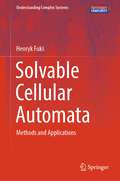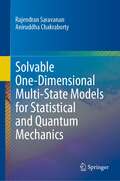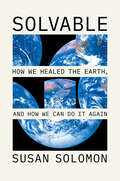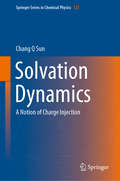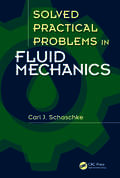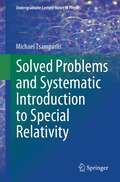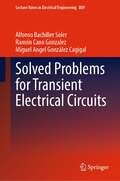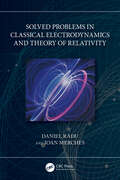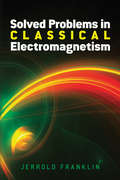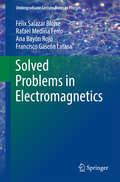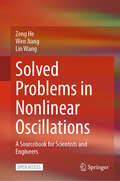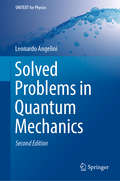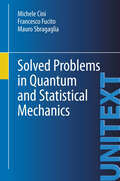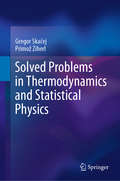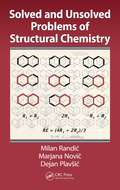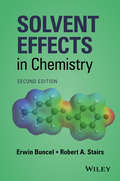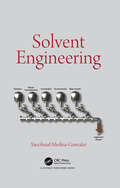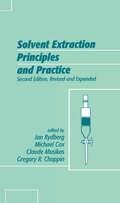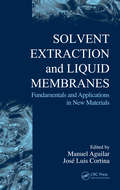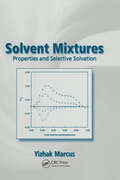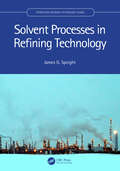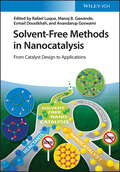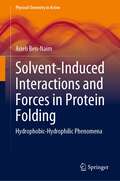- Table View
- List View
Solvable Cellular Automata: Methods and Applications (Understanding Complex Systems)
by Henryk FukśThe main focus of the book is solvability of cellular automata, that is, expressing the state of a given cell after a given number of steps by an explicit formula. The author considers solutions of two types of initial value problems for cellular automata, the deterministic one and the probabilistic one. In the first chapter the basic concepts of cellular automata theory are introduced. Deterministic initial value problem is introduced next and solutions for selected simple rules are also presented. In the following chapters various techniques for solving the deterministic problem are introduced, using elementary CA rules of increasing complexity as examples. The second part of the book introduces the concept of probability measure in the context of cellular automata and the probabilistic initial value problem for both deterministic and probabilistic rules. The book is amply illustrated with examples and applications such as the density classification problem, phase transitions in traffic models or the diffusion of innovations model. In the appendix, solution formulae (both deterministic and probabilistic) for over 60 elementary cellular automata rules are listed. Ruelle-Frobenius-Perron equations for all 88 minimal elementary cellular automata are also provided.
Solvable One-Dimensional Multi-State Models for Statistical and Quantum Mechanics
by Rajendran Saravanan Aniruddha ChakrabortyThis book highlights the need for studying multi-state models analytically for understanding the physics of molecular processes. An intuitive picture about recently solved models of statistical and quantum mechanics is drawn along with presenting the methods developed to solve them. The models are relevant in the context of molecular processes taking place in gaseous phases and condensed phases, emphasized in the introduction. Chapter 1 derives the arisal of multi-state models for molecular processes from the full Hamiltonian description. The model equations are introduced and the literature review presented in short. In Chapter 2, the time-domain methods to solve Smoluchowski-based reaction-diffusion systems with single-state and two-state descriptions are discussed. Their corresponding analytical results derive new equilibrium concepts in reversible reactions and studies the effect of system and molecular parameters in condensed-phase chemical dynamics. In Chapter 3, time-domain methods to solve quantum scattering problems are developed. Along side introducing a brand new solvable model in quantum scattering, it discusses transient features of quantum two-state models. In interest with electronic transitions, a new solvable two-state model with localized non-adiabatic coupling is also presented. The book concludes by proposing the future scope of the model, thereby inviting new research in this fundamentally important and rich applicable field.
Solvable: How We Healed the Earth, and How We Can Do It Again
by Susan SolomonA compelling and pragmatic argument: solutions to yesterday’s environmental problems reveal today’s path forward. We solved planet-threatening problems before, Susan Solomon argues, and we can do it again. Solomon knows firsthand what those solutions entail. She first gained international fame as the leader of an expedition to Antarctica in 1986, making discoveries that were key to healing the damaged ozone layer. She saw a path—from scientific and public awareness to political engagement, international agreement, industry involvement, and effective action. Solomon, an atmospheric scientist and award-winning author, connects this career-defining triumph to the inside stories of other past environmental victories—against ozone depletion, smog, pesticides, and lead—to extract the essential elements of what makes change possible. The path to success begins when an environmental problem becomes both personal and perceptible to the general public. Lawmakers, diplomats, industries, and international agencies respond to popular momentum, and effective change takes place in tandem with consumer pressure when legislation and regulation yield practical solutions. Healing the planet is a long game won not by fear and panic but by the union of public, political, and regulatory pressure. Solvable is a book for anyone who has ever despaired about the climate crisis. As Solomon reminds us, doom and gloom get us nowhere, and idealism will only take us so far. The heroes in these stories range from angry mothers to gang members turned social activists, to upset Long Island birdwatchers to iconoclastic scientists (often women) to brilliant legislative craftsmen. Solomon’s authoritative point of view is an inspiration, a reality check, a road map, and a much-needed dose of realism. The problems facing our planet are Solvable. Solomon shows us how.
Solvation Dynamics: A Notion of Charge Injection (Springer Series in Chemical Physics #121)
by Chang Q SunThis book highlights the latest advances and outlines future trends in aqueous solvation studies from the perspective of hydrogen bond transition by charge injection, which reconciles the solvation dynamics, molecular nonbond interactions, and the extraordinary functionalities of various solutes on the solution bond network and properties. Focus is given on ionic and dipolar electrostatic polarization, O:H nonbond interaction, anti-HB and super-HB repulsion, and solute-solute interactions. Its target audience includes researchers, scientists, and engineers in chemistry, physics, surface and interface science, materials science and engineering.
Solvation Effects on Molecules and Biomolecules
by Sylvio CanutoThis volume is an interdisciplinary treatise on the theoretical approach to solvation problems. It describes the essential details of the theoretical methods and places them into the context of modern applications, and hence is of broad interest to theoreticians and experimentalists. The assembly of these modern methods and applications into one volume is a unique contribution to date and gives a broad and ample description of the field in its present stage of development.
Solved Practical Problems in Fluid Mechanics
by Carl J. SchaschkeContains Fluid Flow Topics Relevant to Every EngineerBased on the principle that many students learn more effectively by using solved problems, Solved Practical Problems in Fluid Mechanics presents a series of worked examples relating fluid flow concepts to a range of engineering applications. This text integrates simple mathematical approaches tha
Solved Problems and Systematic Introduction to Special Relativity (Undergraduate Lecture Notes in Physics)
by Michael TsamparlisIn most undergraduate physics classes Special Relativity is taught from a simplistic point of view using Newtonian concepts rather than the relativistic way of thinking. This results in students often finding it difficult to understand properly the new approach/new ideas, and consequently to solve relativistic problems. Furthermore, a number of books treat the theory using advanced mathematics which is not necessary for the first approach to the theory. This book is intended to serve two roles: a. To treat a student in a systematic constructive way to the basic structure of the theory and b. To provide a large number of solved in-detail problems in the kinematics and dynamics of Special Relativity. Concerning the first aim the book introduces the basics of four-dimensional mathematics, i.e., Lorentz metric, relativistic tensors, and prepares, through working examples, the transition to General Relativity, which requires, besides the relativistic concepts, the use of Differential Geometry and tensor analysis. The presentation is concise and does not replace a book on Special Relativity. Concerning the second intention the large number of problems provides the necessary material which can be used in order to familiarize the student with the relativistic “world”. These problems can be used in the class by the teachers either as working examples or as problem sheets. It will be our pleasure if the book will be useful to both students and teachers.
Solved Problems for Transient Electrical Circuits (Lecture Notes in Electrical Engineering #809)
by Alfonso Bachiller Soler Ramón Cano Gonzalez Miguel Angel González CagigalThis book has been designed for helping students and other interested readers to solve first- and second order circuits problems in the time domain, and to use the Laplace transform. The theory is kept concise, yet all the necessary concepts are explained, and plentiful problems are solved in detail. A vast amount of figures is used for a more effective learning. All in all, this book will help undergraduate and graduate students to develop the necessary skills to solve a broad range of transient exercises. It offers a unique complementary text to classical electric circuit textbooks, for students and self-study, as well.
Solved Problems in Classical Electrodynamics and Theory of Relativity
by Ioan Merches Daniel RaduThis book is intended for undergraduate and graduate students in physics, engineering, astronomy, applied mathematics and for researchers working in related subjects. It is an excellent study tool for those students who would like to work independently on more electrodynamics problems in order to deepen their understanding and problem solving skills. The book discusses main concepts and techniques related to Maxwell's equations, potentials and fields (including Liénard-Wiechert potentials), electromagnetic waves, and the interaction and dynamics of charged point particles. It also includes content on magnetohydrodynamics and plasma, radiation and antennas, special relativity, relativistic kinematics, relativistic dynamics and relativistic-covariant dynamics and general theory of relativity. It contains a wide range of problems, ranging from electrostatics and magnetostatics to the study of the stability of dynamical systems, field theories and black hole orbiting. The book even contains interdisciplinary problems from the fields of electronics, elementary particle theory, antenna design. Detailed, step-by step calculations are presented, meeting the need for a thorough understanding of the reasoning and steps of the calculations by all students, regardless of their level of training. Additionally, numerical solutions are also proposed and accompanied by adjacent graphical representations and even multiple methods of solving the same problem. It is structured in a coherent and unified way, having a deep didactic character, being thus oriented towards a university environment, where the transmission of knowledge in a logical, unified and coherent way is essential. It teaches students how to think about and how to approach solving electrodynamics problems. - Contains a wide range of problems and applications from the fields of electrodynamics and the theory of special relativity. - Presents numerical solutions to problems involving nonlinearities. - Details command lines specific to Mathematica software dedicated to both analytical and numerical calculations, which allows readers to obtain the numerical solutions as well as the related graphical representations.
Solved Problems in Classical Electromagnetism (Dover Books on Physics)
by Jerrold FranklinSolved Problems in Classical Electromagnetism is a valuable tool to help students learn to do physics while using concepts they learn in the courses. Students who are taking or have already taken an advanced EM course will find the book to be a useful adjunct to their textbook, giving added practice in applying what they are learning. For students who are taking an undergraduate EM course and want to get more depth, this book can help them achieve that aim and also help them prepare for graduate work. Beginning students, or those not even taking a course at the moment, can benefit from these problems and learn just from working on them with the help of the solutions. In each chapter, the problems start out relatively easy and then get progressively more advanced, helping students to go just as far as they can at their present level. <p><p> The book includes a number of review sections to assist students without previous advanced training in working out the problems. The first review section is a comprehensive development of vector calculus that will prepare students to solve the problems and provide a strong foundation for their future development as physicists. The problems are drawn from the topics of electrostatics, magnetostatics, Maxwell's equations, electromagnetic radiation, and relativisitc electromagnetism.
Solved Problems in Electromagnetics
by Félix Salazar Bloise Rafael Medina Ferro Ana Bayón Rojo Francisco Gascón LatasaThis book presents the fundamental concepts of electromagnetism through problems with a brief theoretical introduction at the beginning of each chapter. The present book has a strong didactic character. It explains all the mathematical steps and the theoretical concepts connected with the development of the problem. It guides the reader to understand the employed procedures to learn to solve the exercises independently. The exercises are structured in a similar way: The chapters begin with easy problems increasing progressively in the level of difficulty. This book is written for students of physics and engineering in the framework of the new European Plans of Study for Bachelor and Master and also for tutors and lecturers.
Solved Problems in Geophysics
by Elisa Buforn Carmen Pro Agustín UdíasSolving problems is an indispensable exercise for mastering the theory underlying the various branches of geophysics. This book is a collection of nearly 200 problems in geophysics, which are solved in detail showing each step of their solution, the equations used and the assumptions made. Simple figures are also included to help students understand how to reduce a problem to its key elements. The book introduces the equations most commonly used in solving geophysical problems, and presents a series of exercises for the main, classical areas of geophysics - gravity, geomagnetism, seismology, and heat flow and geochronology. Problems range from simple exercises for the most elementary courses to more complex problems suitable for graduate-level students. This handy book is the ideal adjunct to core course textbooks on geophysical theory. It is a convenient source of additional homework and exam questions for instructors, and provides students with a practice or revision aid.
Solved Problems in Nonlinear Oscillations: A sourcebook for scientists and engineers
by Lin Wang Zeng He Wen JiangThis is an open access book. This textbook contains about 200 fully solved problems in analytical and numerical methods for nonlinear osccillations. These comprise all the end-of-chapter problems in Ali H. Nayfeh and Dean T. Mook’s famous textbook Nonliear Oscillations. Mathematical software are adopted to make those solutions more accessible from a graphical point of view. This book can be adopted as a supplement to course work study for graduates or senior undergraduates. Since many exercise problems are adapted from scientific research papers, this book also has a good reference value for scientists and engineers who work in nonlinear vibration.
Solved Problems in Quantum Mechanics (UNITEXT for Physics)
by Leonardo AngeliniThis book presents a large collection of problems in Quantum Mechanics that are solvable within a limited time and using simple mathematics. The problems test both the student’s understanding of each topic and their ability to apply this understanding concretely. Solutions to the problems are provided in detail, eliminating only the simplest steps. No problem has been included that requires knowledge of mathematical methods not covered in standard courses, such as Fuchsian differential equations. The book is in particular designed to assist all students who are preparing for written examinations in Quantum Mechanics, but will also be very useful for teachers who have to pose problems to their students in lessons and examinations.
Solved Problems in Quantum and Statistical Mechanics
by Francesco Fucito Mauro Sbragaglia Michele CiniThis work arises from our teaching this subject during many years. The vast majority of these exercises are the exams we gave to our students in this period. We carefully selected the subjects of the exercises to cover all the material which is most needed and which is treated in the most well known texts on these subjects. Each exercise is carefully solved in full details, explaining the theory behind the solution with particular care for those issues that, from our experience, are found most difficult from the average student. Indeed, several exercises are designed to throw light on aspects of the theory that, for one reason or another, are usually neglected with the result to make the students feel uneasy about them. In fact most students get acquainted just with the more common manipulations, which are illustrated by many examples in textbooks. Our exercises never require extensive calculations but tend to be somewhat unusual and force the solver to think about the problem starting from the principles, rather than by analogy with some previously solved exercise.
Solved Problems in Thermodynamics and Statistical Physics
by Gregor Skačej Primož ZiherlThis book contains a modern selection of about 200 solved problems and examples arranged in a didactic way for hands-on experience with course work in a standard advanced undergraduate/first-year graduate class in thermodynamics and statistical physics. The principles of thermodynamics and equilibrium statistical physics are few and simple, but their application often proves more involved than it may seem at first sight. This book is a comprehensive complement to any textbook in the field, emphasizing the analogies between the different systems, and paves the way for an in-depth study of solid state physics, soft matter physics, and field theory.
Solved and Unsolved Problems of Structural Chemistry
by Milan Randic Marjana Novic Dejan PlavsicSolved and Unsolved Problems of Structural Chemistry introduces new methods and approaches for solving problems related to molecular structure. It includes numerous subjects such as aromaticity-one of the central themes of chemistry-and topics from bioinformatics such as graphical and numerical characterization of DNA, proteins, and proteomes. It a
Solvent Effects in Chemistry
by Robert A. Stairs Erwin BuncelThis book introduces the concepts, theory and experimental knowledge concerning solvent effects on the rate and equilibrium of chemical reactions of all kinds. It begins with basic thermodynamics and kinetics, building on this foundation to demonstrate how a more detailed understanding of these effects may be used to aid in determination of reaction mechanisms, and to aid in planning syntheses. Consideration is given to theoretical calculations (quantum chemistry, molecular dynamics, etc.), to statistical methods (chemometrics), and to modern day concerns such as "green" chemistry, where utilization and disposal of chemical waste or by-products in an environmentally safe way is as important as achieving the desired end products by all chemists nowadays. The treatment progresses from elementary to advanced material in straightforward fashion. The more advanced topics are not developed in an overly rigorous way so that upper-level undergraduates, graduates, and newcomers to the field can grasp the concepts easily.
Solvent Engineering
by Yaocihuatl Medina-GonzalezThis book aims to present the concept of Solvent Engineering within a broad scope, ranging from mixtures of solvents to achieve the desired solvation properties, to stimuli-responsive solvents. It covers diverse aspects such as thermodynamics and transfer phenomena associated with solvent engineering, as well as applications found in recent literature, spanning materials across science, biochemistry, chemistry, and separation and purification processes, among others. Solvent engineering is proposed as an innovative strategy to address environmental concerns related to the use of volatile and toxic solvents. This book highlights efforts to develop engineered solvents that offer more environmentally acceptable alternatives as against those currently in use.
Solvent Extraction Principles and Practice, Revised and Expanded
by Michael Cox Gregory R. Choppin Jan Rydberg Claude MusikasA complete and up-to-date presentation of the fundamental theoretical principles and many applications of solvent extraction, this enhanced Solvent Extraction Principles and Practice, Second Edition includes new coverage of the recent developments in solvent extraction processes, the use of solvent extraction in analytical applications and waste re
Solvent Extraction and Liquid Membranes: Fundamentals and Applications in New Materials
by Manuel Aguilar José Luis CortinaThe applications of solvent extraction (SX) and liquid membranes (LM) span chemistry, metallurgy, hydrometallurgy, chemical/mineral processing, and waste treatment-making it difficult to find a single resource that encompasses fundamentals as well as advanced applications. Solvent Extraction and Liquid Membranes: Fundamentals and Applicat
Solvent Mixtures: Properties and Selective Solvation
by Yitzhak MarcusCompiling, comparing, and analyzing research from a wide range of abstracts, journal articles, and Web sites, this reference examines the properties, function, and behavior of binary, ternary, and multicomponent mixtures in the presence and absence of solutes. The author uniformly presents extensive data on the properties of solvent mixtures and describes their structures and interactions. He details the impact of preferential solvation on the environment, action, and components of chemical systems. The book highlights experimental approaches to determine when, and to what extent, preferential solvation has taken place and models for organic, ionic, macromolecular, and biochemical solutes.
Solvent Processes in Refining Technology (Petroleum Refining Technology Series)
by James G. SpeightThis book focuses on the various solvent processes that are used in crude oil refineries. It presents the differences between each type of process and discusses the types of feedstock that can be used for the processes. This accessible guide is written for managers, professionals, and technicians as well as graduate students transitioning into the refining industry. . Key Features: • Describes the various steps that are necessary for the solvent treatment of various feedstocks in crude oil refineries. Brings the reader up to date and adds more data. Provides an extensive glossary. Considers next-generation processes and developments.
Solvent-Free Methods in Nanocatalysis: From Catalyst Design to Applications
by Rafael Luque Manoj B. Gawande Esmail Doustkhah Anandarup GoswamiSolvent-Free Methods in Nanocatalysis Discover solvent-free approaches for the synthesis of nanocatalysts as well as various catalytic transformations in this unique one-stop resource Solvent-free methods have attracted wide attention in organic synthesis and catalysis as a promising approach towards “greener” and more sustainable chemical transformations. In this regard, nanocatalysis has seen particular growth in recent years. Solvent-Free Methods in Nanocatalysis gives an in-depth overview of nanocatalysts and their catalytic applications using solvent-free methods. After a brief introduction, it covers various synthetic techniques for the preparation of nanocatalysts and supports using solvent-free methods, e.g. ball-milling, microwave- and plasma-assisted methods. The book discusses in detail different catalyst classes, such as metal oxides, doped and functionalized nanocarbons, as well as nitride- and silica-based materials to help researchers to understand the efficiency and nature of these catalysts/supports based on their chemical structure. In the book readers will also find: A brief account of the history, challenges, and recent advances in the field Detailed discussion of advantages and disadvantages of solvent-free techniques for nanocatalyst preparation Treatment of important solvent- and catalyst-free organic transformations (i.e. oxidation, coupling and multicomponent reactions) A chapter on supported ionic liquids for solvent-free catalysis Written by leading researchers in the field, Solvent-Free Methods in Nanocatalysis is a useful reference for researchers and students working in organic synthesis, catalysis, and nanomaterials science.
Solvent-Induced Interactions and Forces in Protein Folding: Hydrophobic-Hydrophilic Phenomena (Physical Chemistry in Action)
by Arieh Ben-NaimThis monograph presents the molecular theory and necessary tools for the study of solvent-induced interactions and forces. After introducing the reader to the basic definitions of solvent-induced interactions, the author provides a brief analysis of the statistical thermodynamics. The book thoroughly overviews the connection of those interactions with thermodynamics and consequently focuses on specifically discussing the hydrophobic-hydrophilic interactions and forces. The importance of the implementation of hydrophilic interactions and forces in various biochemical processes is thoroughly analyzed, while evidence based on theory, experiments, and simulated calculations supporting that hydrophilic interactions and forces are far more important than the corresponding hydrophobic effects in many biochemical processes such as protein folding, self-assembly of proteins, molecular recognitions, are described in detail. This title is of great interest to students and researchers working in the fields of chemistry, physics, biochemistry, and molecular biology.
